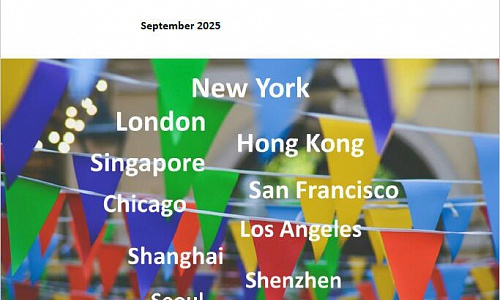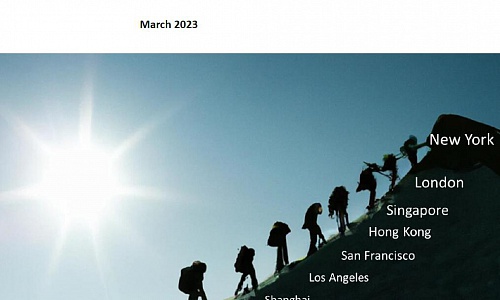Information
 The Global Financial Centres Index 21 (GFCI 21) was launched simultaneously in Shenzhen, China and Milan, Italy on March 27th, 2017. GFCI 21 was jointly compiled by the Z/Yen group and CDI. Key financial centres were scored and ranked from the perspectives of business environment, financial system, infrastructure, human capital, and reputation. CFCI 21 launched the latest scores and ranks of 88 financial centres and analyzed the situations, features and trends of development.
The Global Financial Centres Index 21 (GFCI 21) was launched simultaneously in Shenzhen, China and Milan, Italy on March 27th, 2017. GFCI 21 was jointly compiled by the Z/Yen group and CDI. Key financial centres were scored and ranked from the perspectives of business environment, financial system, infrastructure, human capital, and reputation. CFCI 21 launched the latest scores and ranks of 88 financial centres and analyzed the situations, features and trends of development.
Date: March 27, 2017
Venue: Room 101, CDI Mansion, Shenzhen
Host: CDI, Z/Yen Group
Theme: The Global Financial Centres Index 21
Program
15:00-15:05 Introduction
15:05-15:20 Global Financial Centres Index 21 Launch (GFCI 21)
Mark YEANDLE, Associate Director, Z/Yen Group
LIU Guohong, Director, Department of Finance and Modern Industry, CDI
15:20-15:40 GFCI 21 Greater China Financial Centres Review
YU Lingqu, Research Fellow, Department of Finance and Modern Industry, CDI
15:40-16:10 Interaction
16:00-16:10 Closing Remarks
Highlights
London, New York, Singapore, Hong Kong and Tokyo remain the five leading global financial centres. However, Brexit and the US election have had a significant impact. London and New York fell 13 and 14 points respectively. These are the largest declines (except for Calgary) in the top 50 financial centres. Singapore rose by eight points and is now only 20 points behind New York.
The leading financial centres in the Asia/Pacific region rose in the GFCI ratings. The gap between third place Singapore and second place New York continues to close. There are six cities of mainland China rated in the GFCI 21, including Shanghai, Beijing, Shenzhen, Guangzhou, Qingdao and Dalian. Among them, Shanghai got 715 points, ranks 13rd, rising 3 places in the rankings. Beijing rose significantly, rising ten places. Both Shanghai and Beijing are in the top 20 financial centres. Shenzhen got 701 points, ranks 22nd, the same as it did in GFCI 20. Guangzhou has been enlisted in GFCI Index for the first time and did well with 650 points, ranks 37th. Qingdao won 640 points and ranks 8th just behind Guangzhou. Dalian fell to 75th in the rankings. Apart from that, Chengdu and Hangzhou are regarded as associate financial centres. GFCI 21 shows that China’s financial sector is promising with tremendous opportunities. With the reform and opening-up deepening further, the competitiveness of Chinese financial centres would be continuously strengthened and there would be more financial centres with international influence in mainland China.
Western European financial centres are still volatile. Of the 29 GFCI centres in the region, 16 declined and 12 rose. Geneva recovered some of the ground it lost in GFCI 20. Ratings for Amsterdam, Vienna and Gibraltar fell significantly.
Centres in the USA, with the exception of New York, rose in the index. Los Angeles moved up 20 points into the top 20 global centres. In Canada, Toronto, Montreal and Vancouver all performed well in GFCI 21.
Five of the top six Eastern European centres rose in the ratings. Istanbul was the exception to this pattern, falling 11 points.
Financial centres in the Middle East and Africa did well in GFCI 21. Apart from a very small decline by Dubai, the other main centres improved in the ratings. There were strong rises for Abu Dhabi and Tel Aviv.
Latin American centres continue to struggle. Sao Paulo, Rio de Janeiro and Panama all fell significantly.
According to the respondents asked by the GFCI questionnaire, political and social upheavals are the two significant factors in the GFCI. That is why London, New York and Istanbul declined in GFCI 21.
GFCI 21 was launched simultaneously in Milan and Shenzhen by the Z/Yen Group in London and China Development Institute (CDI) in Shenzhen, which marked the second collaboration between CDI and the Z/Yen on the compiling of GFCI. The GFCI provides profiles, rating and rankings for 88 financial centres, drawing on two separate sources of data – instrumental factors (five broad ‘areas’ of competitiveness, namely business environment, financial sector development, infrastructure, human capital and reputational factors) measured externally and financial centre assessments by in international financial services professionals in an ongoing online questionnaire. It was first published in 2007 and then updated and republished each September and March.
Gallery
https://en.cdi.org.cn/component/k2/item/315-the-global-financial-centres-index-21-launch#sigProId25b0fe079d










